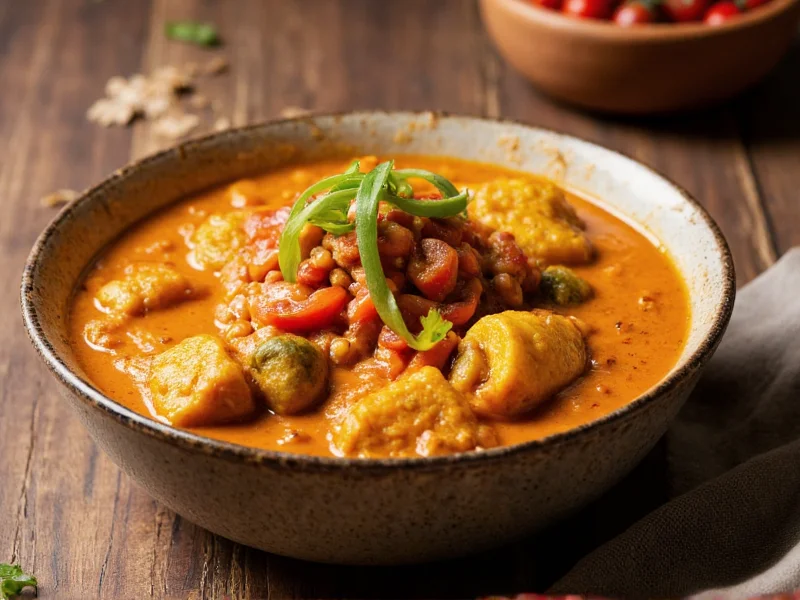Understanding the distinction between curry and chili is essential for home cooks navigating global cuisines. While often confused, these elements represent fundamentally different culinary concepts that frequently intersect in cooking. Curry encompasses both a cooking style and spice blend, whereas chili specifically refers to the pungent peppers that contribute heat to many curry preparations.
What Exactly Is Curry?
Curry isn't a single ingredient but rather a culinary tradition that spans multiple cultures. The term originated from the Tamil word kari, meaning sauce. In Western contexts, "curry" typically refers to:
- Curry dishes - Complexly spiced stews or sauces featuring meat, vegetables, or legumes
- Curry powder - A British-invented spice blend containing turmeric, coriander, cumin, fenugreek, and often chili
- Curry paste - Common in Southeast Asian cooking, made with fresh ingredients like lemongrass and galangal
Authentic regional curries vary dramatically across India, Thailand, Japan, and the Caribbean. Indian curries might use garam masala as their base, while Thai curries rely on fresh herb pastes. The common thread is the layered spice technique rather than any single ingredient.
Understanding Chili: More Than Just Heat
Chili (or chilli) refers to the fruit of plants in the Capsicum genus, which includes hundreds of varieties ranging from mild bell peppers to intensely hot habaneros. Key facts about chilies:
- The heat comes from capsaicin, concentrated in the pepper's placenta (white ribs)
- Measured on the Scoville scale, from 0 (bell peppers) to 2,200,000+ (Carolina Reaper)
- Used fresh, dried, powdered, or smoked (like chipotle)
- Contributes not just heat but distinct flavor notes - fruity, smoky, earthy
Chili powder in Western cooking typically refers to ground dried chilies, often mixed with cumin and garlic powder. This differs from cayenne pepper, which is pure ground dried chili.
| Characteristic | Curry | Chili |
|---|---|---|
| Nature | Culinary tradition/spice blend | Pepper fruit/spice |
| Primary Flavor | Complex, earthy, aromatic | Heat with varying flavor notes |
| Heat Level | Mild to medium (typically) | Mild to extreme (varies by type) |
| Key Components | Turmeric, coriander, cumin, fenugreek | Capsaicin, various volatile oils |
| Common Forms | Dishes, powder, paste | Fresh, dried, flakes, powder |
How Curry and Chili Work Together
While distinct, curry and chili frequently complement each other in global cuisines. Understanding their relationship helps create authentic dishes:
In Indian cooking, fresh green chilies often provide heat in regional curries, while Kashmiri red chilies contribute color without extreme heat. Thai red curry paste includes dried red chilies as a base ingredient, balanced with lemongrass and galangal. Japanese curry roux typically contains mild chili powder for subtle warmth.
The difference between curry leaves and chili is particularly important. Curry leaves (from the Murraya koenigii tree) are aromatic herbs used in South Indian cooking, completely unrelated to chili peppers despite the confusing name.
Practical Cooking Guidance
When working with these ingredients, consider these evidence-based recommendations:
- Substitution awareness: Curry powder cannot replace chili powder (and vice versa) due to their fundamentally different compositions. For mild heat in curry dishes, use paprika rather than extra curry powder.
- Heat management: Remove chili seeds and membranes to reduce heat while preserving flavor. Add chilies early for integrated heat, late for brighter spice notes.
- Regional authenticity: Traditional Thai green curry uses fresh green chilies, not curry powder. Authentic Indian butter chicken relies on garam masala rather than commercial curry powder.
- Storage considerations: Ground spices like curry powder lose potency within 6 months, while whole dried chilies maintain quality for up to a year when stored properly.
Common Misconceptions Clarified
Several persistent myths confuse home cooks:
- "All curry contains chili" - Many traditional Indian curries like butter chicken or korma use minimal or no chili, relying on other spices for flavor.
- "Curry powder is authentic to India" - Most Indian households create fresh spice blends; commercial curry powder was developed for British palates.
- "Chili heat equals flavor quality" - The best chilies offer complex flavor beyond heat, with milder varieties often having more nuanced taste profiles.
- "Curry and chili can be used interchangeably" - Their distinct flavor profiles mean substituting one for the other significantly alters dish character.
Exploring Global Variations
Culinary traditions worldwide have adapted these elements uniquely:
Jamaican curry powder contains allspice and minimal turmeric, creating a distinctive yellow color. Japanese curry roux includes apples and honey for sweetness. Malaysian curries often feature coconut milk and belacan (shrimp paste). Understanding these regional differences helps select appropriate ingredients for authentic results.
For those exploring mild curry dishes without chili, South Indian sambar (lentil stew) or Malaysian curry laksa (when prepared without sambal) offer flavorful options. Conversely, dishes like Szechuan dry-fried chicken showcase chili as the dominant flavor element without curry spices.











 浙公网安备
33010002000092号
浙公网安备
33010002000092号 浙B2-20120091-4
浙B2-20120091-4